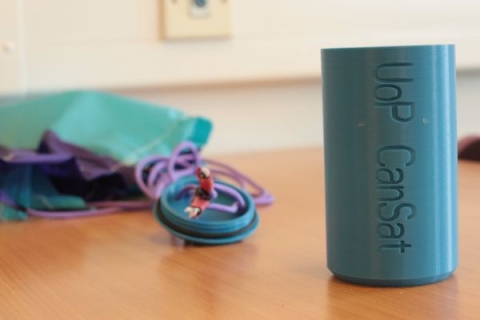

Is it possible to build a satellite in just four weeks? Two students found out this summer as part of an exciting project to build a small CanSat satellite. They even sent it flying off of one of our buildings!
This summer, I was joined by two talented undergraduate students, both about to enter their final BSc year, in order to build the University’s first CanSat.
A CanSat is a small satellite, the size of a 330ml drinks can. Its primary goal is not to orbit in space but instead to teach the end-to-end processes needed for a small satellite build. CanSats are usually ‘launched’ by small rocket, balloon or dropped by drone and typically from heights of 10’s to 100’s of metres. However, they can include all the required subsystems that an orbiting CubeSat would have.
CanSats are commonly used to teach students the process of building a satellite, as well as allowing them to practice the engineering, designing, and coding skills needed. CanSats commonly carry instruments for measuring the climate they are in, so can be used to monitor local variations in the temperature, pressure and humidity.
What can our CanSat do?
Our prototype was a proof-of-concept CanSat, built ahead of the launch of the University’s first CanSat competition. In the competition, students will design a science goal for a small satellite, design a test CanSat to demonstrate part of this science goal, build and launch their satellite and then analyse the resulting data. This will take place this academic year and the build will occur in our first small-sat lab. The competition will be sponsored by companies in the space industry including Harwin, who make space-ready components and connectors for satellites.
The prototype included sensors to monitor the internal environment of the CanSat, including temperature, humidity and pressure; sensors to detect the motion and orientation of the CanSat, such as accelerometers and gyroscopes; and a method of both storing data onboard and transmitting it. We used an SD card reader and a LoRa (long range) radio transceiver to store the data and to transmit it in real-time.
We have lift off
The students not only designed, tested and coded up the electronics for the CanSat and ground station, but also designed and produced the 3D printed structure of the satellite and the parachute. The four-week internship culminated in the project being thrown from the top floor balcony of the Dennis Sciama Building, the home of the University's Institute of Cosmology and Gravitation. The parachute worked a treat and the CanSat operated very well. The students wrote documentation on the first of, hopefully many, small satellites and you can see a video blog explaining their build here.
